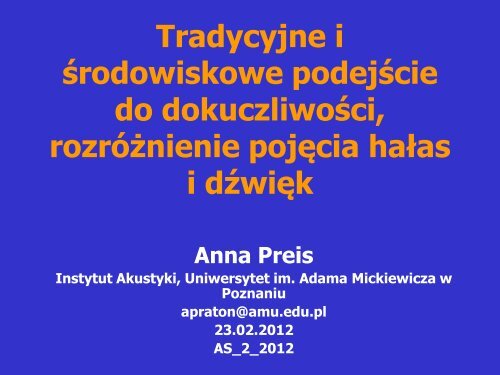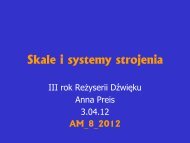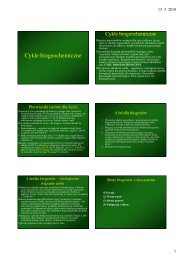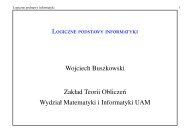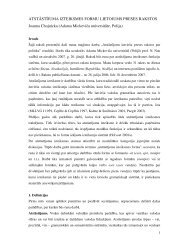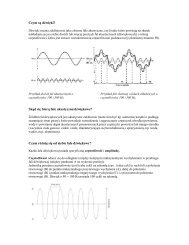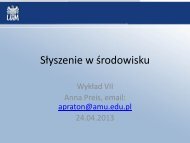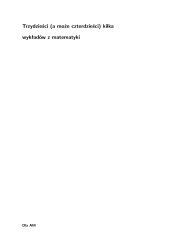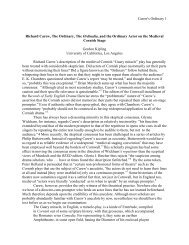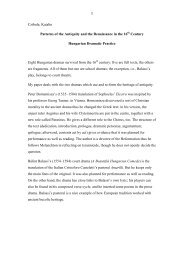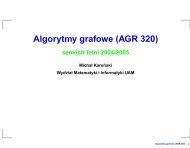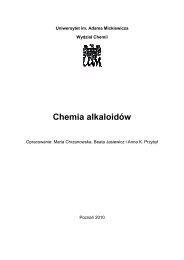good - Uniwersytet im. Adama Mickiewicza
good - Uniwersytet im. Adama Mickiewicza
good - Uniwersytet im. Adama Mickiewicza
Create successful ePaper yourself
Turn your PDF publications into a flip-book with our unique Google optimized e-Paper software.
Tradycyjne i<br />
środowiskowe podejście<br />
do dokuczliwości,<br />
rozróżnienie pojęcia hałas<br />
i dźwięk<br />
Anna Preis<br />
Instytut Akustyki, <strong>Uniwersytet</strong> <strong>im</strong>. <strong>Adama</strong> <strong>Mickiewicza</strong> w<br />
Poznaniu<br />
apraton@amu.edu.pl<br />
23.02.2012<br />
AS_2_2012
Dźwięk i hałas<br />
• Dźwięk- fizyczny bodziec<br />
wywołujące<br />
wrażenie słuchowe<br />
– dźwięk w psychoakustyce<br />
– dźwięk środowiskowy<br />
• Hałas-dźwięk niepożądany
Środowiskowe podejście<br />
do dokuczliwości<br />
Dźwięk środowiskowy<br />
Percepcja<br />
Recepcja<br />
Naturalne środowisko Zniekształcone środowisko<br />
Cechy wrażenia<br />
słuchowego<br />
głośność<br />
wysokość<br />
barwa<br />
Cechy<br />
dokuczliwości hałasu<br />
dokuczliwa głośność<br />
uciążliwość<br />
zawartość informacyjna
Demonstracja<br />
• Dźwięki środowiskowe<br />
• Dokuczliwość dźwięków mowy –<br />
zrozumiałej i niezrozumiałej<br />
• Wpływ informacji na percepcje<br />
głośności dźwięków mowy
Tradycyjne podejście<br />
do dokuczliwości<br />
L DWN =10log[1/24(12x10 0.1LD+ 8x10 0.1(LW+5)+ 4x10 0.1(LN+10 )]<br />
L DWN depends on: L D , L W , L N<br />
L D , L W , L N – day, evening, night<br />
L D<br />
L AeqT<br />
L<br />
AeqT<br />
<br />
<br />
= 10lg<br />
<br />
p<br />
p<br />
2<br />
A<br />
2<br />
o<br />
<br />
<br />
<br />
<br />
p<br />
2<br />
A<br />
1<br />
T<br />
T pA<br />
0<br />
2<br />
( t)<br />
dt
L<br />
A<br />
<br />
<br />
10lg<br />
<br />
p<br />
p<br />
2<br />
A<br />
2<br />
o<br />
<br />
<br />
<br />
stationary source LA<br />
<br />
nonstationary<br />
source<br />
2<br />
( t )<br />
pA<br />
LAE<br />
E<br />
<br />
2<br />
A pA(<br />
t)<br />
<br />
dt<br />
czas
Equivalent continuous A-weighted sound pressure level<br />
L<br />
AeqT<br />
<br />
L<br />
AE<br />
10<br />
<br />
log<br />
<br />
N<br />
<br />
t<br />
o<br />
T<br />
<br />
Sound Exposure Level<br />
L<br />
AE<br />
<br />
10<br />
<br />
log<br />
<br />
E<br />
A<br />
p<br />
2<br />
o<br />
<br />
t<br />
o<br />
<br />
Exposure of sound<br />
E<br />
A<br />
<br />
<br />
<br />
<br />
p<br />
2<br />
A<br />
t<br />
<br />
dt
Decybele A<br />
• Skąd się wzięły?<br />
• Dlaczego są stosowane we<br />
wskaźnikach oceny hałasu (WHO)?
Dokuczliwość<br />
Podejście do dokuczliwości<br />
Tradycyjne<br />
Środowiskowe<br />
Jeden czynnik<br />
Wiele czynników<br />
Parametry hałasu<br />
Parametry hałasu i tła
Wieloczynnikowe WHO<br />
UBA<br />
<br />
<br />
<br />
N<br />
10<br />
<br />
<br />
<br />
1.3<br />
d s f au<br />
sone<br />
1 <br />
A AL<br />
IN<br />
DR<br />
n<br />
PA<br />
<br />
N<br />
(1 w<br />
2<br />
w<br />
2<br />
5 S FR<br />
)
Model głośności w ocenie<br />
dokuczliwości hałasu,<br />
ostrości, chropowatości,<br />
siły fluktuacji i tonalności
Dokuczliwość<br />
• Głośność<br />
• Ostrość<br />
• Chropowatość<br />
• Siła fluktuacji<br />
• Siła wysokości (tonalność)
• Loudness:<br />
• Sharpness:<br />
• Roughness/:<br />
Fluctuation<br />
strength:<br />
• Tonality:<br />
Consideration of distribution of critical bands and<br />
masking properties in the hearing,<br />
DIN 45 631, ISO 532 B<br />
Weighted first moment of distribution of critical band<br />
rates of specific loudness, proportion of high-frequency<br />
spectral components to low-frequency ones<br />
T<strong>im</strong>e structure of the sound signal, modulation factor<br />
and level difference determine roughness amplitudeand<br />
frequency modulation<br />
Share of tonal, narrow-band components of a sound<br />
signal, depending on frequency, level difference and<br />
bandwidth
Dokuczliwość a głośność<br />
• dB<br />
• dB A – trzy przykłady, równy<br />
poziom dźwięku różna dokuczliwość<br />
• Głośność Zwickera ISO 532B<br />
• Głośność Stevensa
74,2 dB 75,1 dB 74,7 dB<br />
Same A-level, Same Third<br />
Octave Spectrum
77.0 dB(A), 36.7 sone<br />
77.0 dB(A), 14.0 sone
S<strong>im</strong>ultaneous
Różna ostrość
white noise<br />
Sharpness: Comparison<br />
von Bismark Aures<br />
of<br />
Bismark / Aures<br />
white noise and amplification of 8 kHz<br />
von Bismark<br />
Aures
Różna chropowatość, siła<br />
fluktuacji
Two Tones, Different<br />
Hearing Events<br />
Sinuston 1 kHz und 1001 1004 1020 1070 1414 Hz<br />
Schwebung<br />
Fluktuation, R-Rauhigkeit Rauhigkeit<br />
Zweiton Komplex Schwankung<br />
(Rumbling, Kollern)
1976<br />
Fundamental<br />
exper<strong>im</strong>ents in headrelated<br />
recording<br />
technology using a<br />
special arrangement<br />
of defined<br />
positionable and<br />
equalized probe<br />
1982<br />
First calibratable<br />
Artificial Head<br />
Measurement System<br />
with true-to-theoriginal<br />
head and pinna<br />
s<strong>im</strong>ulation and transfer<br />
characteristics<br />
Since 1989<br />
Artificial Head<br />
Measurement System<br />
HMS II including<br />
mathematically<br />
describable,<br />
s<strong>im</strong>plified geometry<br />
and typical
Frequency<br />
Outer Ear Transfer Function Artificial Head in the Free Field<br />
Sound incidence direction
20<br />
10<br />
dB<br />
0<br />
-10<br />
-20<br />
-30<br />
H ff<br />
(f,r)<br />
+9 0 o<br />
0 o 0 o<br />
-9<br />
f -> kHz<br />
180 o<br />
0,2 0,5 1 2 5 10 20<br />
sound pressure level<br />
in the left ear of a<br />
test subject<br />
0° sound incidence<br />
from the front<br />
-90° turned to the<br />
side<br />
180° sound incidence<br />
from behind<br />
+90° turned away to<br />
the side<br />
Measurements with Test Persons
Artificial Head, left ear<br />
Measurement Microphon<br />
Sound Source Moving Around a Head
Influence of Spatial Position on<br />
Hearing Event
Two sound sources: Third noise by 4 kHz and temporal sine tone 4 kHz<br />
both sources from the front<br />
Sources +/- 60 grd. left - right
"<strong>good</strong>"<br />
3rd octave<br />
spectrum<br />
spec.<br />
loudness<br />
spec. roughness<br />
Application: Tire noise in the
"noisy"<br />
"<strong>good</strong>"<br />
3rd octave<br />
spectrum<br />
spec.<br />
loudness<br />
spec. roughness<br />
- 3 dB<br />
Example: Tire noise in the
Modulation spectrum versus frequency<br />
"<strong>good</strong>"<br />
“annoying"<br />
strong modulation in the<br />
higher frequent area<br />
15 Hz + harmonics -> Tire rotation<br />
Example: Tire noise in the
frequency selected level versus t<strong>im</strong>e, 2 ms integration t<strong>im</strong>e constant<br />
"<strong>good</strong>"<br />
“annoying"<br />
Example: Tire noise in the<br />
ca. 10 dB level fluctuation<br />
narrow band level at 3200 Hz<br />
vehicle interior<br />
• higher level<br />
• strong temporal structure<br />
ca. 20 dB level difference
"noisy"<br />
significant t<strong>im</strong>eand<br />
frequency<br />
pattern<br />
lower level and<br />
loudness<br />
"Relative Approach"<br />
(Adaptivity of<br />
Human Hearing<br />
"<strong>good</strong>"<br />
Application: Dish
ad<br />
Passing PKW, 100 km/h, engine in running<br />
right artificial head<br />
microphone<br />
left artificial head<br />
microphone<br />
A-weighted sound pressure level<br />
<strong>good</strong><br />
Driving direction from right to left
Loudness
left ear<br />
right ear<br />
bad<br />
<strong>good</strong>
Schärfe nach AURES
Application: Take Off Noise<br />
of Airplanes<br />
• Three different airplanes were be<br />
measured close to an airport in a garden<br />
of a house<br />
• Boeing B 727<br />
• Boeing B 747<br />
• Airbus A 320
A 320<br />
B 747<br />
B 727<br />
stronge change of<br />
loudness vs. t<strong>im</strong>e
prominence
modulation spectrum vs. band
Level, lin.,<br />
A-, B-, C-weighted<br />
Duration T<strong>im</strong>e<br />
Energy<br />
Spectral<br />
Contribution<br />
Subjective<br />
Attitude<br />
Classification<br />
of Sound Event<br />
Temporal<br />
Structure<br />
Signal<br />
Information<br />
Spatial<br />
Distrubution<br />
Quantity<br />
Position<br />
Psychoacoustical Binaural Physical Cognitive Aspect Aspect<br />
Sound Content
LSPL<br />
85 dB(A)<br />
65 dB(A)<br />
Physical damage of hearing possibly caused<br />
by sound<br />
Measurement by sufficient A-weighted sound<br />
pressure level<br />
Physiological <strong>im</strong>pairment caused by sound<br />
A-weighted sound pressure level<br />
measurements necessary but not sufficient<br />
Annoyance by noise with vegetative effects<br />
possible<br />
A-weighted sound pressure level is not suited<br />
for describing the sound quality<br />
Importance of the A-weighted<br />
Sound Pressure Level


